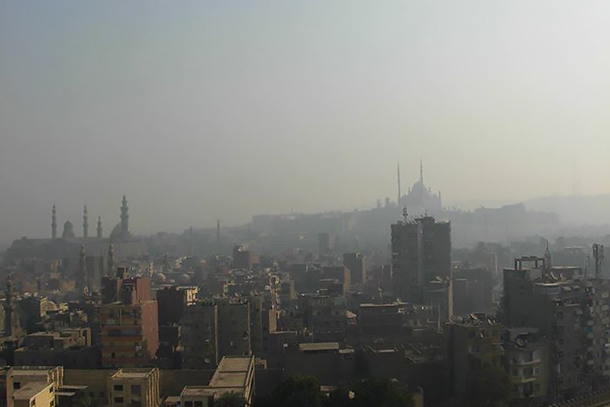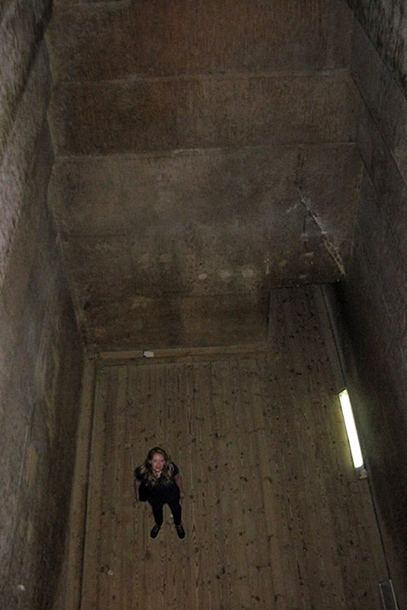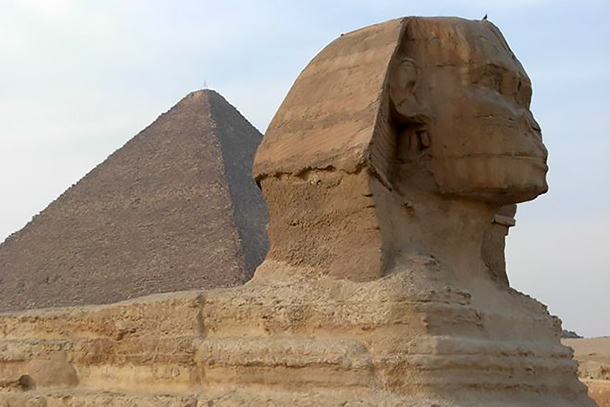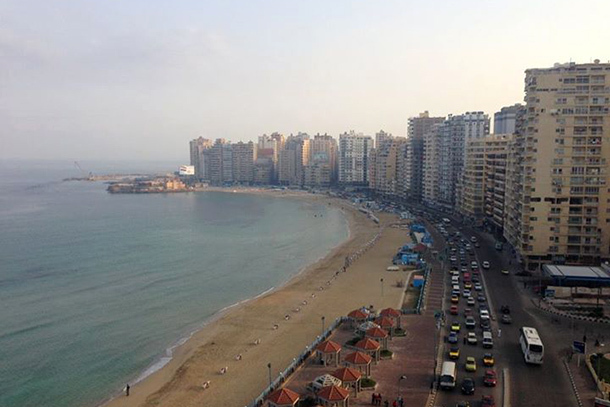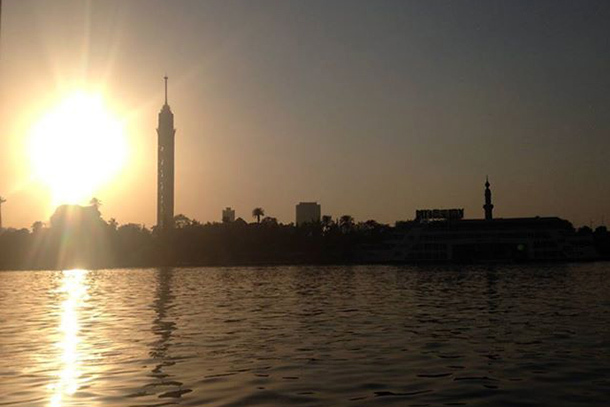
My guide told me that the pyramids were guarded by the gods of silence. Standing deep inside the Red Pyramid, about thirty minutes outside of Cairo, I embraced that deafening quiet. This is what Egypt is like now: The crowds are gone, and on some days it feels like you have the major tourist sites all to yourself.
But Egypt is about to rise again. An overwhelming majority loves the country’s new president, and the country is desperate to bring back visitors to fuel its economy. And it’s no wonder why: Revenue from ancient Egyptian monuments has fallen by 95% since the 2011 revolution, according to some reports.
I visited Cairo, Giza, and Alexandria last month, and here’s what I learned.
The Journey Begins in Cairo
Arriving at Cairo airport is easy. I paid $25 USD in cash at one of the bank windows before getting in the immigration line, and in exchange was given a visa stamp to paste into my passport. (I’d read online that there’s an exit fee as well, but I was never charged; a guide later told me that the government has removed it to attract tourists.) After a short wait in the immigration line, I was officially in the country. Short lines would become a theme on this trip: There really aren’t many other tourists there yet.
Once out of the airport’s secure area, things can get a little stressful. For starters, you can’t escape noise: Drivers honk when they are happy, they honk when there’s danger, and they honk just to hear their horns. In my case, taxi drivers and private cars began fighting for my business the minute I stepped outside. As I walked to the official taxi parking (not a line, just a parking lot full of taxis), I was surrounded by very persistent drivers. I’d heard it’s best to use a taxi with a meter to get to Giza, my first stop on the trip, so I found a taxi driver who claimed to have a working meter. As it turns out, he didn’t. He was also missing seatbelts, so I found another taxi.
In the end, though, finding a car with a meter doesn’t matter so much—I paid about 185 EGP, and I’d been quoted a flat fee of 150 EGP by other drivers. Working seatbelts, on the other hand, are crucial. My driver clearly had another job as a NASCAR driver or bank heist escape vehicle—the man drove like there was someone chasing him.
Traffic in Egypt is quite an experience. Many highways have no marked lanes; instead, cars and mopeds and trucks “share†the road, turning four lanes of traffic into five-and-a-half, swerving within inches of other vehicles, slowing down (but not stopping) for pedestrians crossing the highways in the dark, and tailgating at speeds of close to 80 miles per hour. Headlights? Cars turn them on briefly, but drive with them off for most of the route. (My driver told me it’s considered rude to use headlights, even at night.) Forty-five minutes of heart-pounding, gut-wrenching close calls later, I arrived at my hotel, Mercure Cairo Le Sphinx Hotel, which I chose for its proximity for the pyramids.
A pyramid-view room is worth paying extra: I can safely say there’s nothing quite like waking up to see the pyramids. (Watch out for the haze, though, which often makes it too heavy to see them.) Lounging on a private balcony while watching the sunset over the pyramids is a unique way to end the day, too. The Mercure Cairo Le Sphinx Hotel is clean and offers a great view of the pyramids from its restaurant and pool. Staying in the Giza area is best if you’re planning on touring the pyramids, as you’ll save lots of time which you’d otherwise spend fighting Cairo traffic.
I arranged private day tours of Giza and Alexandria for two people—myself and my travel partner—through Ramasside Tours. Each tour included an Egyptologist guide and a driver with a car for $300 total, including all entrance fees except for admission inside the Great Pyramid, which is extra. While it possible (and cheaper) to hire a taxi to drive you to the various historical sites, you’d be missing out on hearing about the history and stories behind the sites.
I visited three main pyramid sites that day: Dahshur, Saqqara, and Giza. The pyramids at Dahshur are smaller (and older) than those at Giza, and they are less-visited than their more famous counterparts. There was only one other carload of visitors at the Red Pyramid when I arrived, and they were on their way out. A solitary guard handed my partner and me a small light and gestured down—we were to enter the pyramid completely alone.
If you’re thinking of doing this, too, start hitting the Stairmaster now. Inside, you’ll have to climb a long way down a “staircase†(really a slanted ramp with pieces of wood serving as steps) and the opening is too low to stand up while you climb. Even at 5’5″, I had to descend in a crouched squat. Of course, this adds to the experience. I felt like an explorer heading into the depths to discover the tombs for the first time. The air feels thick and old inside the pyramid, which also adds to the sense of danger and excitement. When I emerged into a large chamber inside the pyramid, I could actually see the smooth, flat slabs that were used to construct it. It’s not too far of a stretch to imagine what it would be like to be buried in here for eternity.
Following the Red Pyramid, I visited the Bent Pyramid (it has a faulty design, so it leans to one side). This, too, was deserted. Next up was the step pyramid at Saqqara. Unfortunately, part of it is covered in scaffolding, somewhat ruining the “ancient†feeling. According to our guide, the pyramid was undergoing renovations when the government stopped paying the company to do the work—so they just abandoned the scaffolding, and it has stayed there untouched since.
After these sites, my guide insisted on stopping at a “Papyrus institute.†In hindsight, I probably could have fought harder to get out of the tourist sales pitch here, but I was sold on the idea that this my last chance for a bathroom stop. If you’re not in the market for papyrus, know that there are decent bathrooms right outside the ticket booths for the Giza pyramid—you’ll just need to tip the attendant a pound or so in order to use them.
At Giza, I finally encountered other tourists—a few of them, anyway. My guess: There were maybe 50 other people visiting at the same time as me, which made for a very easy touring experience. I’d read about the pyramids and the Sphinx as a child, seen them in books and on television countless times, but finally standing in front of them is both awe-inspiring and surreal. The size is hard to fathom until you’re right at the base. It’s a marvel.
Inside the Great Pyramid, you can explore the aboveground vaults (although the mummies that used to reside here have long been looted, and the treasures are now displayed in museums). Still, there’s no better way to get a sense for just how great the structure is than by standing inside it.
Chilling out on the Coast
After Giza, I went north to the coastal city of Alexandria, where many Egyptians go for vacation. Alexandria has a much more relaxed feel to it than Cairo and Giza. You can stroll uninterrupted along the water, stopping at the many beachside cafes and restaurants.
If you take the train from Cairo, opt for the fast train, which only takes around two hours; the slower trains take about four hours. You’ll need to make advance reservations to ensure a seat on the fast train. First-class seats (which cost about $20 USD) are large and fairly comfortable, and the trip offers a unique view into the Egyptian countryside life, with farmers tending their fields and people washing their clothes in the river along the way. Bear in mind, however, that there are no rules against smoking on the train, and for Westerners this can feel like an assault on the senses. (All the more reason to take the two-hour train instead of the four-hour ride.)
In Alexandria, I stayed at the Hilton Alexandria Corniche, which quickly became one of my favorite hotels in Egypt. It has the feel of a beach resort hotel, and it’s clean and modern. The sea view from the balcony is beautiful, and there’s even a private beach.
Named for Alexander the Great, Alexandria has an interesting mix of Egyptian, Greek, and Roman culture. There’s an entire sunken city just beneath the water in the harbor of Alexandria, with some 6,000 artifacts left under the surface. Some of the sunken monuments have been excavated, and I was able to view them at the open air museum at the Roman Amphitheater. The Amphitheater itself looks like it came straight from Italy; stand on the marked spot at the center of the stage and you can hear your voice be amplified loudly by design rather than by microphone. Below the surface (on dry ground), you can explore the Catacombs of Kom el Shaqafa, a massive historical burial site. On the more modern side is the New Library of Alexandria, which opened in 2002. There you’ll find everything from exhibits on former presidents to ancient manuscripts. (And it’s free to visit.)
Central Cairo
I ended my trip with two nights in downtown Cairo at the centrally located Ramses Hilton. The neighborhood can’t be beat—you can see Tahrir Square and the Egyptian Museum from many of the rooms, or opt for a Nile view. This is the busiest hotel I stayed at in Egypt, and it seems to be a popular location for weddings, which were a delight to watch from the lobby as the bride and groom are welcomed to their reception by a rowdy band and dancing crowd. Even if you’re not staying there, the rooftop restaurant Windows on the World is worth a visit for its skyline views.
Security at this hotel is high-level and reassuring: All cars are checked for bombs before being allowed to drive up to the entrance and everyone must pass through a metal detector (and their bags through an X-ray) before entering the lobby.
I enlisted the help of the concierge staff at the Hilton to arrange a day tour for my last full day in Egypt. It took less than an hour for them to find a tour and negotiate a good price for us, organize a private driver to the Khan el-Khalili market, set up a taxi to transfer us to the airport, and arrange a sunset boat ride on the Nile.
My favorite parts of Cairo? The Egyptian Museum is incredible, jammed full of ancient treasures. The best of the best was the King Tut Collection—I got to see everything from his gleaming gold mask to his sarcophagus. The other highlight is the boat ride on the Nile. Lined up along the banks are private boats for hire—it’s mostly locals that take these, and they’re kind of a party cruise, blaring loud music, flashing lights, and packed with revelers dancing.
My helpful Hilton concierge arranged for a private boat ride for two (total cost: around $25 for an hour-long cruise) and, somewhat hilariously, had the captain meet us at the hotel in order to walk us across the street, kindergarten crossing-guard style. (Crossing a street in Cairo is an adventure. Locals have mastered the art of calmly walking into traffic, assuming that a car will stop for them, and then moving slowly forward, putting their lives in the hands of the drivers. Navigating the street with a local made it somewhat less stressful). Watching the sun set from the Nile was the perfect end to my time in Egypt, and offered up angles of the city that I hadn’t seen before.
Should You Go?
“Egypt? Isn’t that dangerous?†That was what I heard every time I told someone of my travel plans. Now, having completed my trip, I can say with confidence that the answer is “no.†The country seems to have stabilized. The only time I felt truly in danger was whenever I tried to cross the street—with one caveat. I did experience a significant level of harassment whenever I went somewhere without a guide (despite dressing conservatively and traveling with a male partner). Unfortunately, this is an issue female travelers need to consider before going—walking around, especially in downtown Cairo at night, can be pretty unpleasant.
On the other hand, the majority of locals I met were friendly and were looking to help tourists in any way they could—like the man in Alexandria who saw that we were being swarmed by taxi drivers, asked us where we were going, and told us what a fair price would be (much more than we were being quoted) without expecting anything in return. Egyptian hospitality is legendary for a reason.
So, should you go? I say yes, and go now. It’s cheap and it might be the only chance you’ll ever have to see these wonders of the ancient world minus the modern crowds.
(Photos: Caroline Morse)
You Might Also Like:
- Travel Back in Time to These Amazing Ancient Cities
- 10 Ancient Ruins That Prove All Roads Lead to Rome
- 10 Hidden Places the World Doesn’t Know About
Â
We hand-pick everything we recommend and select items through testing and reviews. Some products are sent to us free of charge with no incentive to offer a favorable review. We offer our unbiased opinions and do not accept compensation to review products. All items are in stock and prices are accurate at the time of publication. If you buy something through our links, we may earn a commission.
Related
Top Fares From
Today's Top Travel Deals
Brought to you by ShermansTravel
6-Night Venice, Dolomites & South Tyrolean...
Edible Destinations
 vacation
$2899+
vacation
$2899+
Alaska: Luxe, 7-Night Inside Passage All-Incl....
Seabourn
 cruise
$4929+
cruise
$4929+
Ohio: Daily Car Rentals from Cincinnati
85OFF.com
 Car Rental
$19+
Car Rental
$19+
